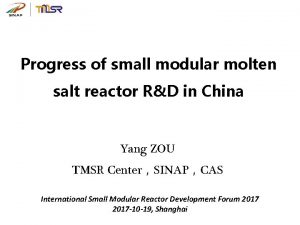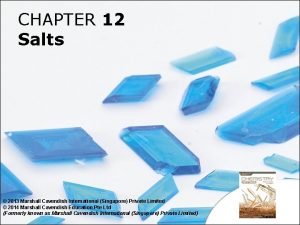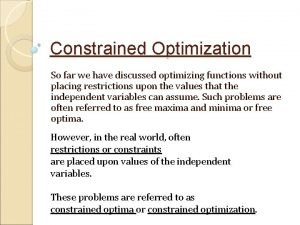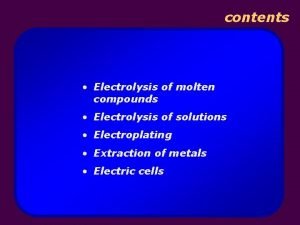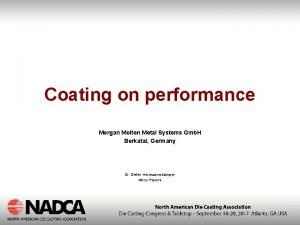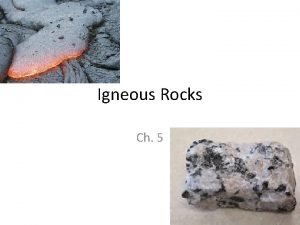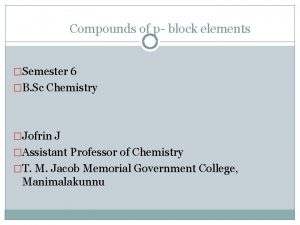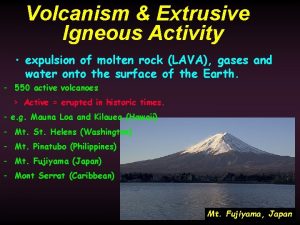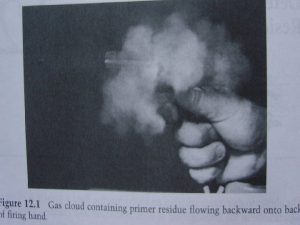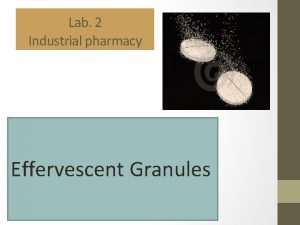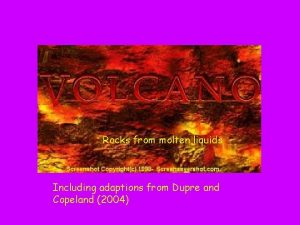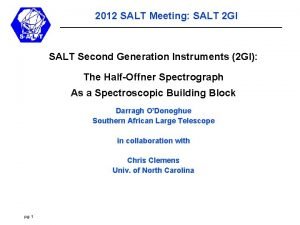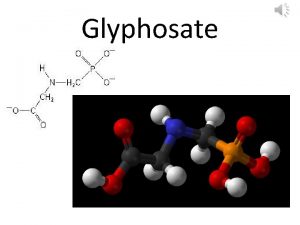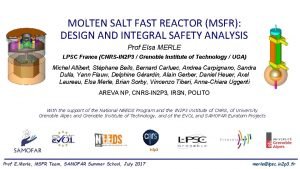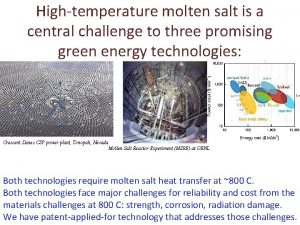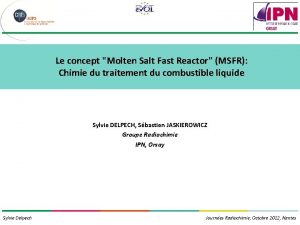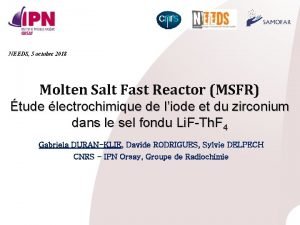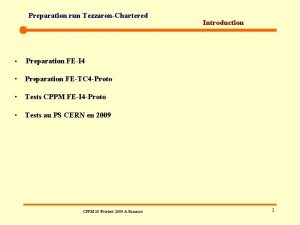Molten Salt Method of Preparation and Optimization of














![X-Ray Powder Diffraction • Determination of crystal structures Sample 5 [5] M. V. Reddy, X-Ray Powder Diffraction • Determination of crystal structures Sample 5 [5] M. V. Reddy,](https://slidetodoc.com/presentation_image_h/8e4b6a3de3ce6d14eceea06854f36e94/image-15.jpg)














- Slides: 29

Molten Salt Method of Preparation and Optimization of Ti. O 2 Phases Chan Tze Yang, Aloysius 1, 2, M. V. Reddy 2, 3*, S. Adams 3 and B. V. R. Chowdari 2 1 2 SRP Student, Hwa Chong Institution, 661, Bukit Timah Road Singapore 269734 Department of Physics, Faculty of Science, National University of Singapore, 2 Science Drive 3, Singapore 117542 3 Department of Materials Science and Engineering, National University of Singapore, Singapore 117546 *Corresponding main mentor’s e-mail address: phymvvr@nus. edu. sg ; msemvvr@nus. edu. sg http: //www. researcherid. com/rid/B-3524 -2010 http: //scholar. google. com. sg/citations? user=p. WKr 2 M 0 AAAAJ&hl=en 1

2

High Costs Low Charge Rates Low Thermal Stability Low Theoretical Capacity Graphite 3

4

Preparation of Compounds Ti. OSO 4 1 Molten Salt Method 10 0. 375 0. 18 0. 445 Li. NO 3 Na. NO 3 KNO 3 5

Preparation of Compounds Ti. O 2 Sample Name Temperature Used (°C) Sample 1 145 Sample 2 280 Sample 3 380 Sample 4 480 Sample 5 850 reheated from Sample 1 6

Preparation of Electrodes Ti. O 2 nanoparticl es Carbon Black Polyvinylide ne Fluoride 70% 15% 7

Preparation of Electrodes 8

Fabrication of Cells 9

Scanning Electron Microscopy • Identification of surface morphology Sample 1 Sample 2 Sample 3 10

Scanning Electron Microscopy • Identification of surface morphology Sample 4 Sample 5 11

Scanning Electron Microscopy Spheric al 12

X-Ray Powder Diffraction • Determination of crystal structures Sample 2 Anatas e Sample 3 Sample 4 13

X-Ray Powder Diffraction • Determination of crystal structures Amorphous Sample 1 14
![XRay Powder Diffraction Determination of crystal structures Sample 5 5 M V Reddy X-Ray Powder Diffraction • Determination of crystal structures Sample 5 [5] M. V. Reddy,](https://slidetodoc.com/presentation_image_h/8e4b6a3de3ce6d14eceea06854f36e94/image-15.jpg)
X-Ray Powder Diffraction • Determination of crystal structures Sample 5 [5] M. V. Reddy, X. W. Valerie Teoh, T. B. Nguyen, Y. Y. Michelle Lim, and B. V. R. Chowdari. 2012. Effect of 0. 5 M Na. NO 3: 0. 5 MKNO 3 and 0. 88 M Li. NO 3: 0. 12 M Li. Cl Molten Salts, and Heat Treatment on Electrochemical Properties of Ti. O 2. Journal of The Electrochemical Society, 159 (6) A 762 A 769. Anatase 15

Cyclic Voltammetry • Investigate the redox behavior of Ti. O 2 in the electrolyte • Voltage Range: 1. 0 V – 2. 8 V • Scan Rate 0. 058 m. V/s 16

Cyclic Voltammetry Anodic Scan (Ti 3+/4+) Cathodic Scan (Ti 4+/3+) Sample 1 Cathodic Scan (Ti 4+/3+) Sample 3 Sample 2 Anodic Scan (Ti 3+/4+) Cathodic Scan (Ti 4+/3+) Sample 4 Anodic Scan (Ti 3+/4+) Cathodic Scan (Ti 4+/3+) Sample 5 17

Galvanostatic Cycling & Capacity Fading • Determine the suitability of using Ti. O 2 as anode material • Voltage Range: 1. 0 V – 2. 8 V • Current Rate: 33 m. A g-1 18

Galvanostatic Cycling Sample 1 Sample 3 Sample 2 Sample 4 Sample 5 19

Capacity Fading Studies Sample 1 Sample 3 Sample 2 Sample 4 Sample 5 20

Capacity Fading Studies Compoun d Initial Capacity (m. A g-1) Capacity at Percentage 5 th cycle 50 th cycle of capacity (m. A g-1) fading Sample 1 Sample 2 Sample 3 98 251 202 69 197 189 57 172 141 17. 4 12. 7 25. 4 Sample 4 323 242 88 63. 6 Sample 5 113 27 76. 1 21

Electrochemical Impedance Spectroscopy • Determine the electrode kinetics within the cell • Voltage Range: 1. 0 V – 2. 8 V • Frequency Range: 0. 003 Hz – 180000 Hz • AC Amplitude: 10 m. V 22

Electrochemical Impedance Spectroscopy Sample 1 Sample 3 Sample 2 Sample 4 Sample 5 23

Electrochemical Impedance Spectroscopy Sample 1 Sample 3 Sample 2 Sample 4 Sample 5 24

Electrochemical Impedance Spectroscopy Sample Number Average Charge Transfer Resistance Discharging (ohms) Charging (ohms) Sample 1 ~1500 ~250 Sample 2 ~300 ~40 Sample 3 ~250 ~150 Sample 4 ~600 ~90 Sample 5 ~550 ~50 25

Conclusions Amorpho us Ti. O 2 Reheat Anatase Ti. O 2 26

Conclusions Lower Production Temperature Better Electrochemical Properties 27

Conclusions Low Costs Of Production Environment al Friendliness High Capacity Retention Highly suitable alternative anode material in Li -ion Batteries 28

Thank You 29
 Tmsr
Tmsr Half reaction
Half reaction Molten press method of wax pattern
Molten press method of wax pattern Carbonate salts examples
Carbonate salts examples Soluble salts can be made by mixing acids and alkalis
Soluble salts can be made by mixing acids and alkalis Interval halving method optimization
Interval halving method optimization So far we have discussed
So far we have discussed Difference between secant method and false position method
Difference between secant method and false position method Fibonacci method optimization
Fibonacci method optimization Keep chaos at bay
Keep chaos at bay Graphite permanent mold casting
Graphite permanent mold casting Molten ionic compounds examples
Molten ionic compounds examples Molten ionic compound
Molten ionic compound Morgan molten metal systems
Morgan molten metal systems Summary of bayonet charge
Summary of bayonet charge Metal flow engineering
Metal flow engineering Rock guide with pictures
Rock guide with pictures Crystallize
Crystallize Xenon oxyfluorides
Xenon oxyfluorides Gossip's bridle torture
Gossip's bridle torture Molten carbonate fuel cell
Molten carbonate fuel cell Expelled molten rock
Expelled molten rock Molten weld pool
Molten weld pool Molten ionic compounds conduct electricity
Molten ionic compounds conduct electricity What is dermal nitrate test
What is dermal nitrate test Symposium method of teaching pdf
Symposium method of teaching pdf What is fusion method of ointment preparation
What is fusion method of ointment preparation Old method of preparation of mother tincture
Old method of preparation of mother tincture Effervescent granules examples
Effervescent granules examples 7 basic preparation method of meat
7 basic preparation method of meat
